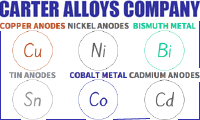
Curated with aloha by
Ted Mooney, P.E. RET

The authoritative public forum
for Metal Finishing 1989-2025

-----
Anode surface area calculation in plating (anode to cathode ratio)
Q. When calculating anode surface area of a basket with nuggets, do I use the facial area or the facial area plus some factor? We have nickel S-rounds in a titanium basket?
Thomas Christianplating engineer - Sanford, North Carolina
September 15, 2008
A. Hi, Thomas. I use the whole surface area (sides and rear as well as front) of the basket. For example, I'd consider the area of a 4" x 2" x 12" deep anode basket to be 1 square foot. If you do a patient search you'll find other opinions here, but here is my reasoning --
First, when articles are written that mention anode to cathode ratio, they are quick guidelines, not deep studies involving surface topology and diffusion dynamics. So the authors surely were thinking in terms of easily measured things like basket area. If you were able to do some deep study and determine, for example, a given extra percentage surface area, it would immediately change anyway as the anodes dissolved. Anode to cathode ratio is just a quick and rough empirical guideline, not a deep and precise science.
Second, how does the surface area of a baseball-sized sponge compare to the surface area of an actual baseball. Is it the same, or a thousand times higher? My answer is it's the same because they have the same zone of highest current density or flux or ion transport. The 'door' to the sponge and to the baseball, through which all the current and ions must pass, is a 3" diameter sphere.
My reasoning for using sides and back as well as front is that if I were using round stick anodes I'd use their whole surface area, and I don't feel the area of anodes in a basket can be considered less than the area of sticks. Further, you'd surely have to count the area of the sides if the baskets were very widely spaced, and to say you won't count them if tightly packed would lead to the somewhat silly conclusion that adding anode baskets might not add anode surface area. One guy's opinion :-)
Regards,

Ted Mooney, P.E.
Striving to live Aloha
finishing.com - Pine Beach, New Jersey
September 16, 2008
Q. Hi everyone,
I have bought a 30 liter tank for electroplating of precious metals. Dimensions are 30*30*34(L*W*H) cm. The calculated maximum surface for electroplating in one time is for 32 big bangles, approximately 2500 square cm. Now, what is the necessary surface of anodes? Is it O.K. with 4 anodes, each side 2 anodes, each one 14*28 cm?
- Iran
May 28, 2013
A. Hi Mary. Your description of the anode arrangement sounds conventional and correct. So I would not change it, and I would consider the anode area to be 3136 square cm.
I can't picture getting 32 big bangles into a 30*34 cm plane "the thin way", though, where the anodes are looking at the diameter of the bangles (seeing 32 zeros or letter O's) -- which is what you would want for heavy plating. It seems like about 9 would fit that way.
If you are plating micron or thinner gold, though, and this is jewelry rather than electronics, I think your plan can probably work without overloading the solution or the anodes. Still would you want to put maybe three times as much gold on some areas of the bangles as on other areas, or wouldn't it be better to plate fewer at a time and rack them for consistent thickness? Good luck.
Regards,

Ted Mooney, P.E.
Striving to live Aloha
finishing.com - Pine Beach, New Jersey
June 1, 2013
Q. Hey Ted,
Thanks for your response. Yes, the application is just for jewelry items and for electroplating of Au, Rh and Ru...
So, Does the anodes sound reasonable?
- Esf, Iran
June 8, 2013
A. Hi. Yes, the anodes sound right to me.
Regards,

Ted Mooney, P.E.
Striving to live Aloha
finishing.com - Pine Beach, New Jersey
June 9, 2013
adv.: Supplier of Copper Anodes, Nickel Anodes, Bismuth Metal, & Other Metal Products for Industry & The Arts

Q, A, or Comment on THIS thread -or- Start a NEW Thread